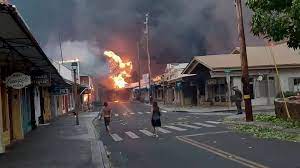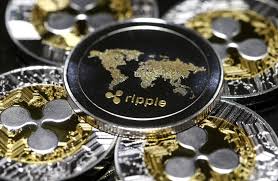Authorities in Hawaii’s Maui Island say a wildfire that tore through the gorgeous tourist town of Lahaina has killed at least 36 people, forced hundreds of residents to evacuate, and left smoldering ruins in its wake.
As the wildfires blocked off most roads leading out of Lahaina, the historic former capital of the Hawaiian Kingdom, video footage showed neighborhoods and businesses destroyed and automobiles burned to a crisp over the western half of the U.S. Island. The town is one of Maui’s top tourist destinations, bringing approximately 2 million visitors annually, or about 80% of the Island’s visitors. The National Weather Service stated the fires in Maui were sparked by a combination of dry vegetation, strong winds, and low humidity, however, the exact cause was yet unknown. Dustin Kaleiopu, a resident of Maui, claimed on Thursday that his family, who has since moved to the opposite side of the island, had only a few minutes to flee and had lost two-generational family houses to the flames. “There are still so many people that we are unable to get in touch with, and that still remains true for many families here,” Kaleiopu said in an interview with NBC News’ “Today” program. “Everyone I know is homeless right now,” These images of destruction are all too common elsewhere in the world. Tens of thousands of people had to be evacuated this summer due to wildfires in Greece, Spain, Portugal, and other regions of Europe, which were frequently sparked by the region’s record-breaking heat. A series of particularly intense fires in western Canada polluted the air by spreading clouds of smoke over large areas of the United States. According to scientists, human-caused climate change, which is being fueled by the use of fossil fuels, is making these extreme weather events more frequent and intense. Scientists have long warned that governments must reduce emissions in order to avoid a global climate catastrophe. Thomas Smith a professor of environmental geography at the London School of Economics and Political Science said wildfires happen in Hawaii every year, but this year’s fires are burning bigger and quicker than usual due to the low rainfall, higher temperatures, and adjacent storm systems. THREE DIFFERENT BLAZESFirefighters were battling three different fires on the island of Maui, according to officials late on Wednesday night. Kula, a residential neighborhood in the inland, mountainous Upcountry region, was also partially burned by the flames, according to officials on Wednesday. Also affected by fires was Kihei in South Maui. The fires started on Tuesday evening as the hurricane’s strong winds, which were hundreds of miles to the southwest, fueled the flames. The severe winds had mostly subsided by Thursday. In addition to the lives lost, the fire also destroyed cultural landmarks like the 60-foot-tall banyan tree in Lahaina that served as a marker for the location of Hawaiian King Kamehameha III’s palace during the 19th century, according to local media. According to official records from flyovers made by the Maui Fire Department and the U.S. Civil Air Patrol, about 271 structures were damaged or destroyed. On Maui, which has a year-round population of 165,000, as of early Thursday, the tracking website Poweroutage.us estimated approximately 11,000 households and businesses were without power. Lahaina, a community of around 13,000 inhabitants, experienced a rapid spread of wildfires across its residential neighborhoods. According to a Maui County press release, some persons dived into the Pacific Ocean to escape the smoke and fire conditions, which prompted the U.S. Coast Guard to rescue them. The Honolulu Star-Advertiser said that on Tuesday, 38-year-old Julius Limbaga was awakened from slumber by the smell of smoke in his Lahaina residence. The fire spread so quickly that it was everywhere, according to Limbaga. He told the press that he showered himself in water before running to the Lahaina harbor while the rubber on his slippers melted. He was pulled from the harbor waters by the Coast Guard and taken to be treated for burns on his legs and feet. The medical director of Maui’s Malama I Ke Ola Health Centre, Dr. John Vaz, told the Star-Advertiser that the majority of new patients first remained silent and “just stood around with blank faces.” But the trauma is beginning to surface as they begin to eat and become a little more animated, he claimed. The Hawaii Department of Transportation’s Ed Sniffen reported late on Wednesday that more than 11,000 travelers had to be evacuated from Maui. Despite the fact that at least 16 roads were closed, Sniffen had earlier in the day stated that the airport was completely operational and that airlines were lowering their prices and providing waivers to help people leave the island. In response to the evacuation efforts, Southwest Airlines said on Thursday that it will be expanding its flights to Hawaii. On Thursday, at 8:30 a.m., the mass bus evacuation of visitors from West Maui to the Kahului Airport was scheduled to resume.
According to President Joe Biden, the U.S. Department of Transportation assisted with evacuation efforts as the National Guard, U.S. Navy, Marines, and Coast Guard were mobilized.

















